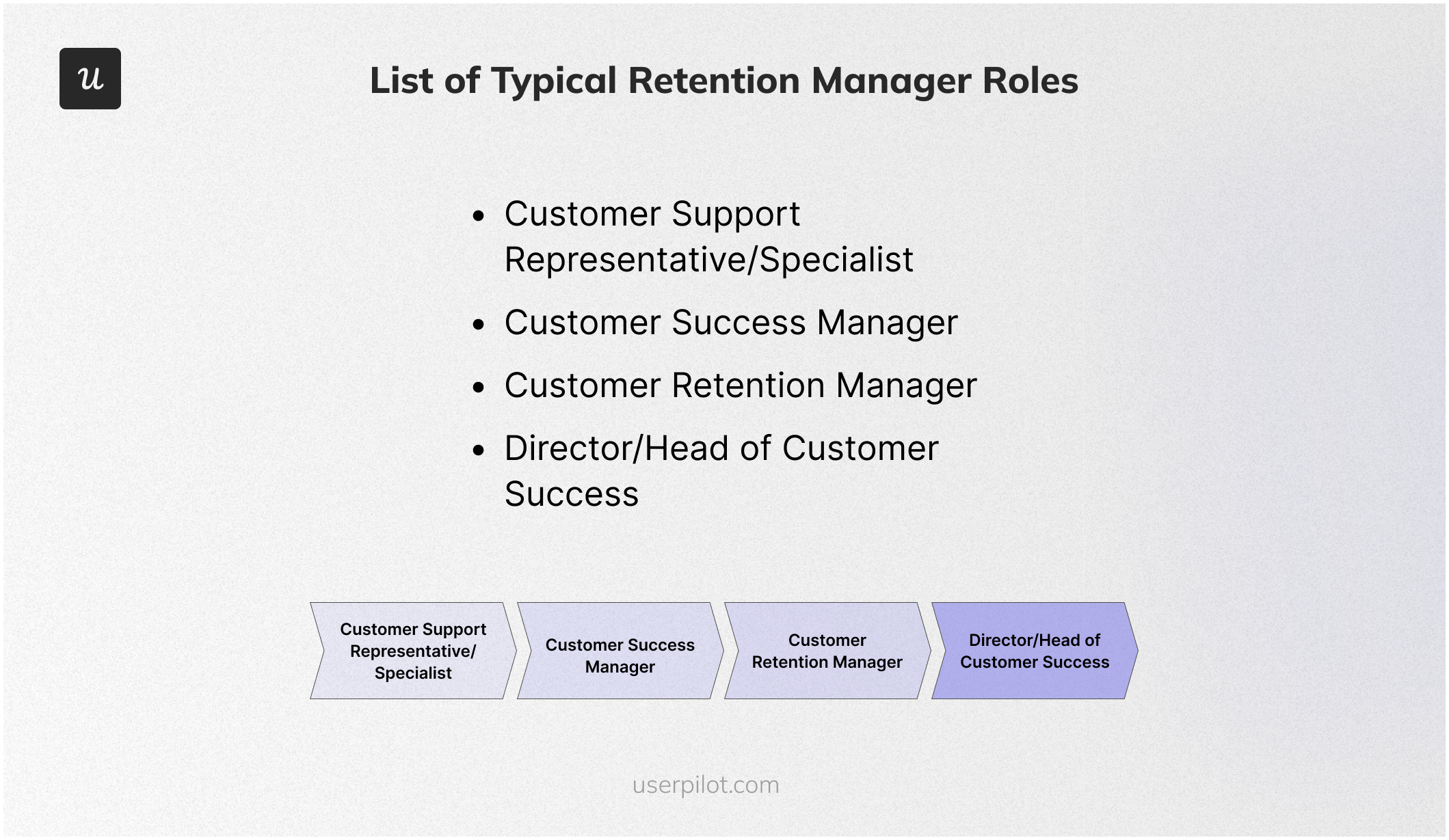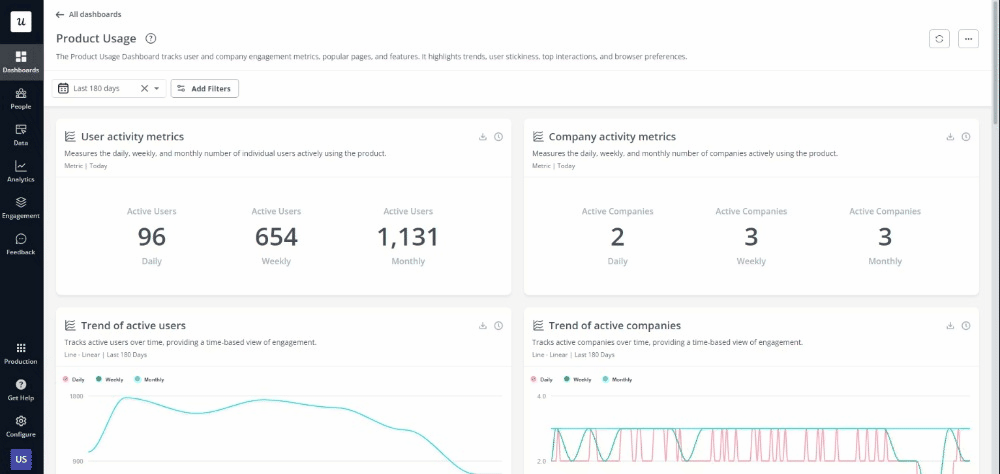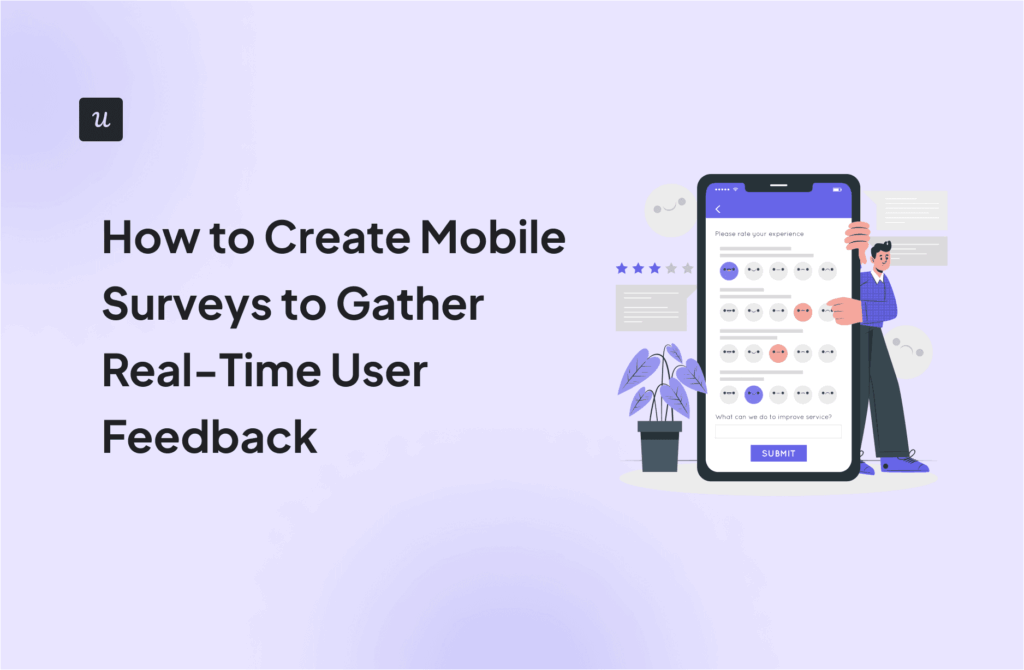![How to Become a Retention Manager [+Tools and Resources]](https://blog-static.userpilot.com/blog/wp-content/uploads/2024/07/How-to-Become-a-Retention-Manager-Tools-and-Resources.png)
Try Userpilot Now
See Why 1,000+ Teams Choose Userpilot

How to become a retention manager?
- This is a business professional who focuses on keeping existing clients happy and doing business with the company. They develop strategies to reduce customer churn (the rate at which customers stop using a service) and increase customer loyalty.
- A career path for a retention manager typically involves several stages, each with increasing responsibilities and opportunities for specialization. Here’s a general outline of how one might progress in this field:
- Customer Support Representative/Specialist (1-3 Years)
- Customer Success Manager (3-5 Years)
- Customer Retention Manager (5+ Years)
- Director/Head of Customer Success (8+ Years)
- Becoming a retention manager often starts with a degree in human resources or business, but relevant experience in customer service or sales is equally valuable.
- Boosting your qualifications through certifications and developing skills in data analysis, communication, and problem-solving can set you apart.
- Customer retention managers rely on various tools to enhance customer satisfaction and loyalty. Userpilot and Custify offer solutions for onboarding, in-app engagement, and personalized experiences. ClientSuccess and ChurnZero focus on B2B customer success, health scoring, and churn prediction, etc.
- Looking into tools for retention managers? Userpilot is an all-in-one product platform with engagement features and powerful analytics capabilities. Book a demo to see it in action!
What is a retention manager?
This is a business professional who focuses on keeping existing clients happy and doing business with the company. They develop strategies to reduce customer churn (the rate at which customers stop using a service) and increase customer loyalty.
Retention manager’s main responsibilities
A retention manager, specifically a customer retention manager, tackles tasks centered around keeping clients happy and preventing them from churning or discontinuing service. Their day-to-day involves a mix of strategy, analysis, and customer interaction. Here’s a breakdown of their core responsibilities:
- Develop and implement customer retention strategies: This involves identifying areas for improvement and crafting plans to address them. They might design loyalty programs, create targeted campaigns, or streamline onboarding processes.
- Analyze customer data and trends: Retention managers are data detectives. They use customer information to identify churn risks, understand customer needs, and measure the effectiveness of retention programs.
- Collaborate with other departments: They work closely with marketing, sales, and customer success teams to ensure a cohesive customer experience that fosters loyalty.
Proactive Customer Engagement:
- Identify at-risk customers: They analyze data to pinpoint customers who show signs of dissatisfaction or decreased engagement, and who might be on the verge of churning.
- Develop targeted interventions: Once at-risk customers are identified, retention managers strategize how to win them back. This might involve personalized offers, educational resources, or proactive outreach from a customer success representative.
- Design customer engagement initiatives: They create campaigns to keep customers engaged with the product or service. This could involve webinars, exclusive content, or loyalty program updates.
Overall Customer Experience:
- Monitor customer satisfaction: Retention managers keep a pulse on customer sentiment through surveys, feedback forms, and social media monitoring.
- Recommend solutions to improve customer experience: By understanding customer pain points, they can propose improvements to products, services, or support processes.
Retention manager career path

A career path for a retention manager typically involves several stages, each with increasing responsibilities and opportunities for specialization. Here’s a general outline of how one might progress in this field:
- Customer Support Representative/Specialist (1-3 Years): This is your foundation, providing hands-on experience resolving customer issues and building communication skills. Strong customer service skills and a genuine desire to help are crucial.
- Customer Success Manager (3-5 Years): Here, you move from reactive support to proactive engagement. You’ll onboard new customers, ensure product adoption, and identify potential churn risks. Develop deep product knowledge and sharpen your ability to build customer relationships.
- Customer Retention Manager (5+ Years): In this role, you will be responsible for developing and implementing strategies to reduce customer churn. You’ll leverage data analytics to identify churn patterns, design targeted retention programs, and collaborate with other departments to optimize the customer journey. Expertise in customer data analysis, program development, and strategic thinking is key.
- Director/Head of Customer Success (8+ Years): You’ll lead the entire customer success team, setting the vision and overseeing all strategies related to customer acquisition, retention, and growth. Strong leadership skills, experience managing teams, and a proven track record of success in customer success are essential.
How to become a retention manager?
The path to becoming a retention manager typically starts with a bachelor’s degree in human resources, business administration, or a related field.
However, relevant experience is often just as valuable. You can gain this experience through internships or entry-level roles in customer service, sales, or human resources. These positions will expose you to the fundamentals of customer interactions, data analysis, and relationship management.
To enhance your qualifications and make yourself a more competitive candidate, consider pursuing certifications such as the Professional in Human Resources (PHR) or Senior Professional in Human Resources (SPHR). Additionally, developing skills in data analysis, communication, negotiation, and problem-solving will prove invaluable.
Networking within the industry is also crucial. Attend industry events, join online forums or groups (like LinkedIn groups focused on talent management or retention), and connect with professionals in the field to learn about potential opportunities and gain insights into the role.
What skills should a retention manager have?
Retention managers are the strategists behind the scenes, leveraging data and creativity to keep customers happy and prevent churn. But what skills does it take to excel in this crucial role?
Here’s a breakdown of the key skills employers often seek:
Analytical Skills:
- Data Analysis and Interpretation: Sifting through customer or employee data to identify trends, predict churn, and measure the success of retention initiatives.
- Problem-Solving: Identifying root causes of dissatisfaction and developing effective solutions.
- Knowledge of Tools: Familiarity with no-code product analytics tools like Userpilot for report sharing, CRM tools for customer relationship management, and SQL for data querying.
Interpersonal Skills:
- Communication: Clearly articulating ideas, actively listening to feedback, and building rapport with customers or employees.
- Empathy: Understanding and addressing the needs and concerns of others.
- Relationship Building: Fostering trust and loyalty through genuine interactions and proactive support.
Strategic Skills:
- Planning and Implementation: Developing and executing comprehensive retention strategies that align with overall business goals.
- Project Management: Coordinating and overseeing various retention initiatives, ensuring timely completion and effective resource allocation.
Best certifications for retention managers
While experience is invaluable, possessing the right certifications can demonstrate your commitment to the field and equip you with the knowledge and skills to excel. Here’s a look at some of the best certifications:
- Professional in Customer Experience (PCX) Certification (Customer Experience Professionals Association (CXPA)): This broader certification focuses on the entire customer experience journey, including customer retention. It can enhance your understanding of factors that influence customer loyalty.
- Google Data Analytics Professional Certificate (Google on Coursera): Retention decisions are often data-driven. This practical certification equips you with skills in data collection, analysis, and visualization using Google tools to identify trends and develop data-backed retention strategies.
- Certified Business Analysis Professional (CBAP) Certification (International Institute of Business Analysis (IIBA)): Retention managers often analyze customer data and feedback to identify areas for improvement. This certification validates your business analysis skills, which can be valuable for uncovering the root causes of customer churn.
- Project Management Professional (PMP) Certification (Project Management Institute (PMI)): Retention programs can involve project management aspects. This certification equips you with methodologies for managing projects like loyalty program development or churn reduction initiatives.
Best resources for retention managers
Here are some of the best resources you can leverage for your career advancements:
Best books for retention managers
To excel in this role, staying up-to-date on the latest trends and best practices is essential. Here are some of the best books for retention managers, packed with valuable insights and actionable strategies:
- “The Effortless Experience” by Matthew Dixon, Nick Toman, and Rick DeLisi: This book delves into the concept of minimizing customer effort, highlighting how it’s often more effective for retention than exceeding expectations. It provides practical advice on creating seamless customer experiences that foster loyalty.
- “Customer Success” by Nick Mehta, Dan Steinman, and Lincoln Murphy: A comprehensive guide to the field of customer success, this book covers everything from onboarding and adoption to renewal and expansion. It offers a framework for building a customer-centric organization that prioritizes retention.
- “Fighting Churn With Data” by Carl Gold: This book is a treasure trove for data-driven retention managers. It outlines how to leverage data analytics to identify churn risks, understand customer behavior, and develop targeted retention strategies.
- “Never Lose a Customer Again” by Joey Coleman: This book emphasizes the importance of the first 100 days of the customer relationship. It provides actionable strategies for creating memorable onboarding experiences that set the stage for long-term loyalty.
- “The Ten Principles Behind Great Customer Experiences” by Matt Watkinson: This book explores the psychology of customer satisfaction and loyalty, offering practical advice on how to create positive experiences that resonate with customers.
Best webinars for retention managers
To stay on top of the latest strategies and trends in customer retention, here are some of the best webinar sources for retention managers:
- Userpilot Events: Userpilot often offers webinars on various aspects of user onboarding, engagement, and retention. They often feature industry experts and provide actionable insights on how to improve product adoption and customer loyalty.
- BrightTALK: It features a wide range of webinars on customer retention, covering topics like churn prevention, customer success strategies, and data-driven retention techniques.
- Gainsight Pulse Academy: Gainsight’s online learning platform offers a variety of webinars and courses on customer success and retention, covering topics like customer journey mapping, health scoring, and renewal management.
- ChurnZero Webinars: Its webinars focus on churn prediction, customer health scoring, and automated playbooks for preventing churn. They provide actionable advice and real-world examples of how to reduce churn and improve customer retention.
Best blogs for retention managers
Here’s a curated list of some of the best blogs for retention managers, packed with valuable insights and actionable tactics:
- Userpilot Blog: (Of course!) Packed with practical advice and data-driven insights on user onboarding, product adoption, and customer engagement. They cover various aspects that directly contribute to reducing churn and improving customer retention.
- Gainsight Blog: A leading customer success platform, Gainsight offers a wealth of resources on customer success and retention. Their blog features thought leadership articles, case studies, and practical tips for building a successful customer success operation.
- Baremetrics Blog: Baremetrics, a subscription analytics platform, offers a blog with insightful articles on SaaS metrics, churn analysis, and growth strategies. Their content is data-driven and provides actionable insights for SaaS companies looking to understand and improve their retention rates.
- Close.com Blog: Close.com offers sales software with a strong focus on customer success. Their blog features practical advice on customer onboarding, building customer relationships, and reducing churn in the SaaS space.
Best podcasts for retention managers
Retention managers can benefit immensely from the insights and strategies shared in these top-rated podcasts.
- Retain: The Customer Retention Podcast: Hosted by Lauren DeSouza, this podcast dives deep into the world of customer retention strategies. Episodes feature interviews with marketing experts and thought leaders who share insights on reducing churn, increasing customer loyalty, and building a strong customer experience.
- Masters of Scale with Reid Hoffman: While not solely focused on retention, this popular podcast often features discussions on scaling businesses, which inherently involves retaining customers. It offers valuable insights into company culture, leadership, and growth strategies
- The Intuitive Customer Podcast: Hosted by Colin Shaw, a renowned customer experience expert, and Prof. Ryan Hamilton, the podcast delves into the psychology of customers and how to create experiences that resonate with them emotionally. The podcast provides insights into customer emotions, motivations, and decision-making processes, helping retention managers design strategies that foster loyalty and reduce churn.
Best tools for retention managers
Customer retention managers play a pivotal role in ensuring customer satisfaction and loyalty, ultimately driving long-term profitability. To achieve this, they need access to powerful tools that help them understand customer behavior, personalize engagement, and proactively address potential churn risks.
Here’s a curated list of 10 essential tools that empower retention managers to excel in their roles:
- Userpilot – Best for onboarding, in-app engagement, and user behavior analytics. It helps retention managers understand how users interact with their products. It allows for creating personalized in-app experiences, guiding users through key features, and gathering feedback to improve the product and ultimately increase retention.
- ClientSuccess – Best for B2B customer success management and retention. ClientSuccess provides a platform for managing customer health scores, tracking engagement, and identifying potential churn risks.
- ChurnZero: Best for churn prediction, customer health scoring, and automated playbooks. ChurnZero uses AI and machine learning to predict which customers are most likely to churn.
- Custify – Best for B2B customer success automation and personalized engagement. Custify streamlines customer success processes, automates repetitive tasks, and provides a centralized view of customer data.
- Customer.io – Best for customer engagement and lifecycle marketing automation. Customer.io allows retention managers to create targeted email campaigns, personalized messaging, and automated workflows based on customer behavior and data.
- HubSpot Service Hub – Best for omnichannel customer support and ticketing. HubSpot Service Hub provides a unified platform for managing customer inquiries, complaints, and feedback across multiple channels.
- Power BI – Best for data visualization and custom reporting. Power BI empowers retention managers to create interactive dashboards and reports to track key retention metrics, identify trends, and make data-driven decisions.
- Amplitude – Best for product analytics and user behavior tracking. Amplitude helps retention managers understand how users interact with their products, identify pain points, and optimize the user journey.
- Qualtrics – Best for customer feedback and experience management. Qualtrics provides a comprehensive platform for collecting and analyzing customer feedback through surveys, polls, and other channels.
- Userfeel – Best for usability testing and user experience feedback. Userfeel allows retention managers to gather real-time feedback from users as they interact with the product.
Retention manager FAQs
What is a retention role?
A retention role is any position within a company that focuses on keeping customers or employees engaged and happy, preventing them from leaving (churning) for competitors or other opportunities.
What is the role of a retention officer?
A retention officer is an entry-level or mid-level position within the retention field. Responsibilities may include:
- Data analysis: Assisting with identifying at-risk customers or employees through data analysis.
- Communication: Reaching out to at-risk customers or employees via phone, email, or chat to understand their concerns and potentially offer solutions.
- Program support: Helping implement and manage retention programs, such as loyalty programs or employee engagement initiatives.
- Reporting: Tracking and reporting on retention metrics (e.g., churn rate) to measure the effectiveness of retention efforts.
What does a retention program manager do?
A retention program manager is a more senior-level position responsible for developing, implementing, and managing the overall customer or employee retention strategy.
What does a retention supervisor do?
A retention supervisor is the team leader who coaches retention officers, sets goals, monitors performance, and escalates complex issues.
Conclusion
Becoming a successful retention manager requires dedication, continuous learning, and a proactive approach to developing relevant skills.
By following the outlined steps and leveraging the resources available, you can effectively navigate your career path and achieve your professional goals.
We hope this guide has provided you with valuable insights and practical advice to help you on your journey to becoming a proficient and impactful retention manager!
Looking into tools for retention managers? Userpilot is an all-in-one product platform with engagement features and powerful analytics capabilities. Book a demo to see it in action!








